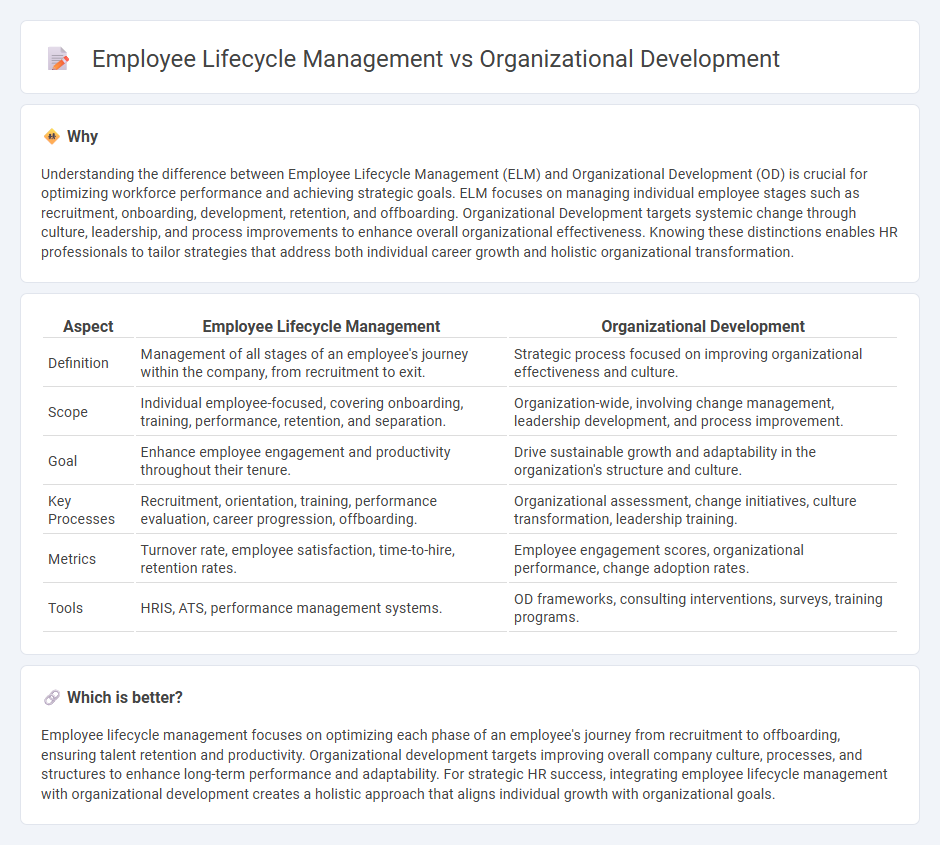
Employee lifecycle management focuses on optimizing each stage of an employee's journey from recruitment to exit, enhancing workforce productivity and retention metrics. Organizational development targets systemic improvements through culture change, leadership development, and strategic alignment to drive long-term business performance. Explore the nuanced differences between these HR strategies to elevate your company's talent and growth initiatives.
Why it is important
Understanding the difference between Employee Lifecycle Management (ELM) and Organizational Development (OD) is crucial for optimizing workforce performance and achieving strategic goals. ELM focuses on managing individual employee stages such as recruitment, onboarding, development, retention, and offboarding. Organizational Development targets systemic change through culture, leadership, and process improvements to enhance overall organizational effectiveness. Knowing these distinctions enables HR professionals to tailor strategies that address both individual career growth and holistic organizational transformation.
Comparison Table
| Aspect | Employee Lifecycle Management | Organizational Development |
|---|---|---|
| Definition | Management of all stages of an employee's journey within the company, from recruitment to exit. | Strategic process focused on improving organizational effectiveness and culture. |
| Scope | Individual employee-focused, covering onboarding, training, performance, retention, and separation. | Organization-wide, involving change management, leadership development, and process improvement. |
| Goal | Enhance employee engagement and productivity throughout their tenure. | Drive sustainable growth and adaptability in the organization's structure and culture. |
| Key Processes | Recruitment, orientation, training, performance evaluation, career progression, offboarding. | Organizational assessment, change initiatives, culture transformation, leadership training. |
| Metrics | Turnover rate, employee satisfaction, time-to-hire, retention rates. | Employee engagement scores, organizational performance, change adoption rates. |
| Tools | HRIS, ATS, performance management systems. | OD frameworks, consulting interventions, surveys, training programs. |
Which is better?
Employee lifecycle management focuses on optimizing each phase of an employee's journey from recruitment to offboarding, ensuring talent retention and productivity. Organizational development targets improving overall company culture, processes, and structures to enhance long-term performance and adaptability. For strategic HR success, integrating employee lifecycle management with organizational development creates a holistic approach that aligns individual growth with organizational goals.
Connection
Employee lifecycle management directly influences organizational development by aligning talent acquisition, onboarding, performance management, and offboarding processes with strategic business goals. Effective lifecycle management fosters continuous learning and skill enhancement, which drives organizational culture and improves workforce productivity. This integration ensures sustainable growth and adaptability in a competitive market.
Key Terms
Organizational development:
Organizational development focuses on enhancing a company's structure, culture, and processes to improve overall effectiveness, employee engagement, and adaptability in a dynamic market. It involves strategies like change management, leadership development, and performance improvement to foster sustainable growth and innovation. Explore the key methodologies and benefits of organizational development to transform your business environment.
Change management
Organizational development centers on systematic change initiatives that improve company culture, processes, and overall effectiveness, while employee lifecycle management focuses on managing each stage of an employee's journey, from recruitment to exit, ensuring engagement and retention. Change management within organizational development involves strategies like communication plans, training programs, and leadership alignment to smoothly implement transformations and minimize resistance. Explore how integrating change management into both frameworks can drive sustained organizational success.
Culture transformation
Organizational development emphasizes culture transformation by aligning company values, leadership practices, and employee behaviors to foster a resilient and adaptive workplace. Employee lifecycle management focuses on maintaining culture through structured onboarding, continuous engagement, and retention strategies to support sustained organizational growth. Discover how integrating these approaches can drive impactful culture change and improve overall business performance.
Source and External Links
What Is Organizational Development? A Complete Guide - Organizational development (OD) is a planned process involving stages from diagnosing organizational issues to implementing change interventions and evaluating their effectiveness to support growth, innovation, and cultural transformation in organizations.
What is Organizational Development? - OD is a systematic, research-driven process that changes organizational strategies, culture, and procedures to improve performance, foster adaptability, and create sustainable growth.
What Is Organization Development? - Organization development focuses on aligning strategy, structure, people, and processes through a holistic, long-term effort to enhance organizational capability and effectiveness using science-backed, interdisciplinary methods.
 dowidth.com
dowidth.com